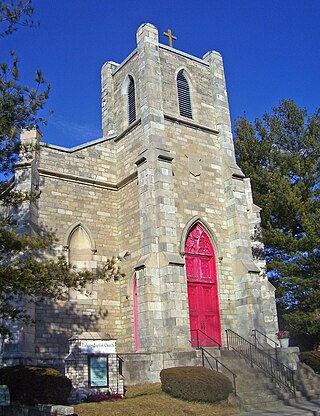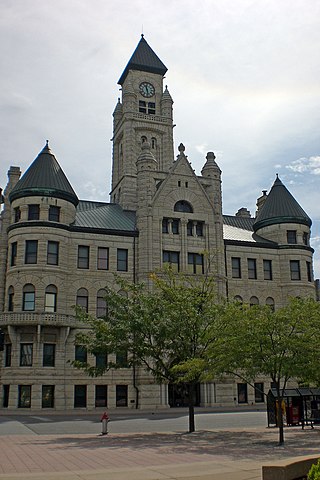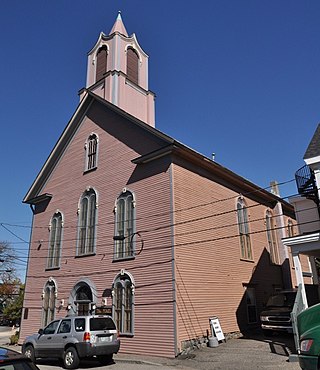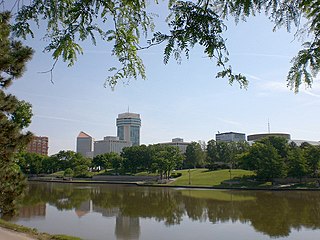
Calvary Baptist Church is a historic Baptist church building at 601 North Water Street in Wichita, Kansas. It was listed on the National Register of Historic Places in 1988.

Calvary Baptist Church is a historic Baptist church building at 601 North Water Street in Wichita, Kansas. It was listed on the National Register of Historic Places in 1988.
Calvary Baptist Church was organized 1878 to serve the growing African-American population of the city. [1] By the 1880s, there were two-dozen black families on Main Street in the shadow of the Sedgwick County Courthouse. Most had moved to Wichita from southern states after the Civil War. The city continued to attract black residents and by the 1920 census, the black population of Wichita was 3,545 with a total population of 72,200. Membership at Calvary Baptist Church stood at 500 and 15 other congregations thrived in the city. The historic black community grew to encompass a 15-block area by the 1950s when urban renewal attempts displaced many of the area's residents. [2]
The congregation relocated to a new structure approximately 4 mi (6.4 km) north in 1972 and Sedgwick County acquired the historic structure in 1975. The building currently houses The Kansas African American Museum. [3]
The structure was built between c.1917 and 1920 and replaced an earlier church on the site constructed in 1911 and soon deemed unsafe by the state fire marshall. [2] It is designed in the classical revival style and constructed of red brick with limestone accents.
The church building is located on the west side of Water Street, north of Elm Street. The Sedgwick County Jail, constructed between 1990 and 2001 wraps around three sides of the church. [4] The structure measures 50 ft × 94 ft (15 m × 29 m) with a 8 ft × 26 ft (2.4 m × 7.9 m) one-story addition at the rear. The two main floors sit on a raised basement.
The east façade is dominated by the entrance which consists of a triangular pediment resting on four two-story limestone columns. A flight of stairs leads from the street level to a small portico containing entrance doors. A Dentiled cornice extends from the pediment around the building just above the second floor.
The interior is dominated by the Akron-plan worship space which occupies the center of the building. The main sanctuary is on the main level with a three-level balcony that wraps three sides and allows for increased capacity. The chancel occupies one corner of the space with the organ pipes in the wall above. Portions of the main floor can be closed to accommodate Sunday school classes or other activities. The sanctuary contains several stained glass windows and an octagonal stained glass skylight. Many of the windows were donated by members of the congregation and contain dedications.
The congregation purchased the organ from the M. P. Moller Company for $3,900. It contains 21 stops with three manuals. The lower level contains additional meeting space, offices and restrooms.
The Negro Star reported in its September 24, 1920 edition that the total construction cost for the facility was $60,000. [2]

Calvary Baptist Church, originally St. Paul's Episcopal Church, is located on St. Paul's Place in Ossining, New York, United States. It is a stone building in the Gothic Revival architectural style, considered the best preserved early example of that style in Westchester County. It is also one of the few remaining Calvin Pollard buildings in the state. Built in the 1830s, it is the oldest house of worship in the village. In 1978 it and its rectory across the street were added to the National Register of Historic Places.

The former First Baptist Church is a historic Baptist church building located at 8601 Woodward Avenue in Detroit, Michigan. Built in 1909, it was designed by architect Guy J. Vinton in the Late Gothic Revival style. It is now the Peoples Community Church. The building was added to the National Register of Historic Places on August 3, 1982.

The Universalist Society Meetinghouse is an historic Greek Revival meetinghouse at 3 River Road in Orleans, Massachusetts. Built in 1834, it was the only Universalist church built in Orleans, and is architecturally a well-preserved local example of Greek Revival architecture. The Meeting House is now the home of the Orleans Historical Society and is known as the Meeting House Museum. It was listed on the National Register of Historic Places in 1999.

The Wichita-Sedgwick County Historical Museum is a non-profit 501(c)(3) organization dedicated to preserving and presenting the local history of Wichita and Sedgwick County, Kansas, United States. It is located at 204 South Main, and east of the former Wichita Public Library.

South Reading Academy is a historic former school building at 7 Foster Street in Wakefield, Massachusetts, US. Built in 1828–29 for the First Baptist Church, the building has served as a religious school, public high school, clubhouse, and commercial space. The building was listed on the National Register of Historic Places in 1989.

United Baptist Church of Lakeport is a historic church at 35 Park Street in the village of Lakeport in Laconia, New Hampshire, United States. Built in 1891 after a fire destroyed an older church, it is an eclectic local example of Late Victorian architecture. It was listed on the National Register of Historic Places in 1985.

The First Free Will Baptist Church is a historic church on Granite Road in Ossipee, New Hampshire. The wood-frame white clapboarded building was built in 1856–57, and is a fine little-altered local example of a vernacular Greek Revival country church. The building was listed on the National Register of Historic Places in 1984.

The Union Church is a historic church on South Main Street in South Wolfeboro, New Hampshire, United States. Built in 1845 for the use of several small religious congregations, it is a well-preserved example of mid-19th century vernacular Greek Revival architecture. The building was listed on the National Register of Historic Places in 1982.

The Freewill Baptist Church—Peoples Baptist Church—New Hope Church is a historic structure built in 1868 located at 45 Pearl Street in Portsmouth, New Hampshire. The building, a fine local example of Italianate ecclesiastical architecture, was once owned by an African-American congregation. It was listed on the National Register of Historic Places in September 2002, and the New Hampshire State Register of Historic Places in January 2002. Later home to the Portsmouth Pearl, a center of arts and culture, it has more recently hosted art exhibitions, theatrical productions, and event rentals. As of June 2021, the building is listed for sale at nearly $1.5 million.

The First Baptist Church, also known as the Old Corner Church, is a historic church at West and Federal Streets in Waterboro, Maine. Built in 1803-04 and altered to a Greek Revival appearance in 1849, it retains significant characteristics of more traditional Federal period meetinghouses. The building was listed on the National Register of Historic Places in 1988.
The First Baptist Church is a historic church building on High Street, off Maine State Route 172 in Sedgwick, Maine. It was designed in Greek Revival style by architect Benjamin S. Deane, based on published drawings by Asher Benjamin, and built in 1837 for a congregation founded in 1805. It is one of coastal Maine's finest Greek Revival churches, and was listed on the National Register of Historic Places in 1973.

The William Lawrence House is a historic house in Bellefontaine, Ohio, United States. Located along Main Street north of the city's downtown, it is historically significant as the home of William Lawrence, a prominent U.S. Representative during the late nineteenth century.

First Baptist Church is located in central Davenport, Iowa, United States. It was listed on the National Register of Historic Places in 1983 as Calvary Baptist Church/First Baptist Church. It is affiliated with American Baptist Churches USA.
Midtown is a neighborhood in Wichita, Kansas, United States. A mixed commercial and residential area on the east bank of the Little Arkansas River, it is the oldest neighborhood in the city.

The Union Meetinghouse or Universalist Church is a historic church building at 97 Amesbury Road in Kensington, New Hampshire. Built in 1839–40, it is a well-preserved and little-altered example of a mid-19th century Greek Revival rural church. It was listed on the National Register of Historic Places in 2013, and continues to be used for summer services.
Church Square is a city block in downtown Columbus, Georgia home to two churches: First Baptist Church of Columbus and St. Luke United Methodist Church. The block, located between 2nd and 3rd Avenues and 11th and 12th Streets, is significant because it is the only remaining square designated for church use by Edward Lloyd Thomas, who surveyed the area in 1828 and drew up the original city plan. The square was listed on the National Register of Historic Places on December 2, 1980.

Goshen Historic District is a national historic district located at Goshen, Elkhart County, Indiana. The district encompasses 751 contributing buildings and 1 contributing site in the central business district and surrounding residential sections of Goshen. The town was developed between about 1840 and 1930, and includes notable examples of Italianate and Queen Anne style architecture. Located with in the district are the separately listed Elkhart County Courthouse and Goshen Carnegie Public Library. Other notable buildings include the Kindy Block (1881), Central Block (1882), Spohn Building (1909), Harper Block (1888), Noble Building, Jefferson Theater (1907), General Baptist Church (1859), First Methodist Church (1874), and St. James Episcopal Church (1862).

Downtown Wichita is the central business district of Wichita, Kansas, United States. The political and financial hub of the city, it is home to several of the area's major landmarks and event venues including the Epic Center, Century II Performing Arts & Convention Center, Intrust Bank Arena, and the Old Town entertainment district.

McAdams is a neighborhood in Wichita, Kansas, United States. A mixed industrial and residential area northeast of Downtown Wichita, it is a historical center of the city’s African American community.

The Shrine of the Black Madonna of the Pan African Orthodox Christian Church, or more simply the Shrine of the Black Madonna, is a church building located at 7625 Linwood Street in Detroit, Michigan. It is significant for its association with civil rights leader Rev. Albert B. Cleage Jr., and as the location of many significant 20th century African American civil rights activities. The building was listed on the National Register of Historic Places in 2021.